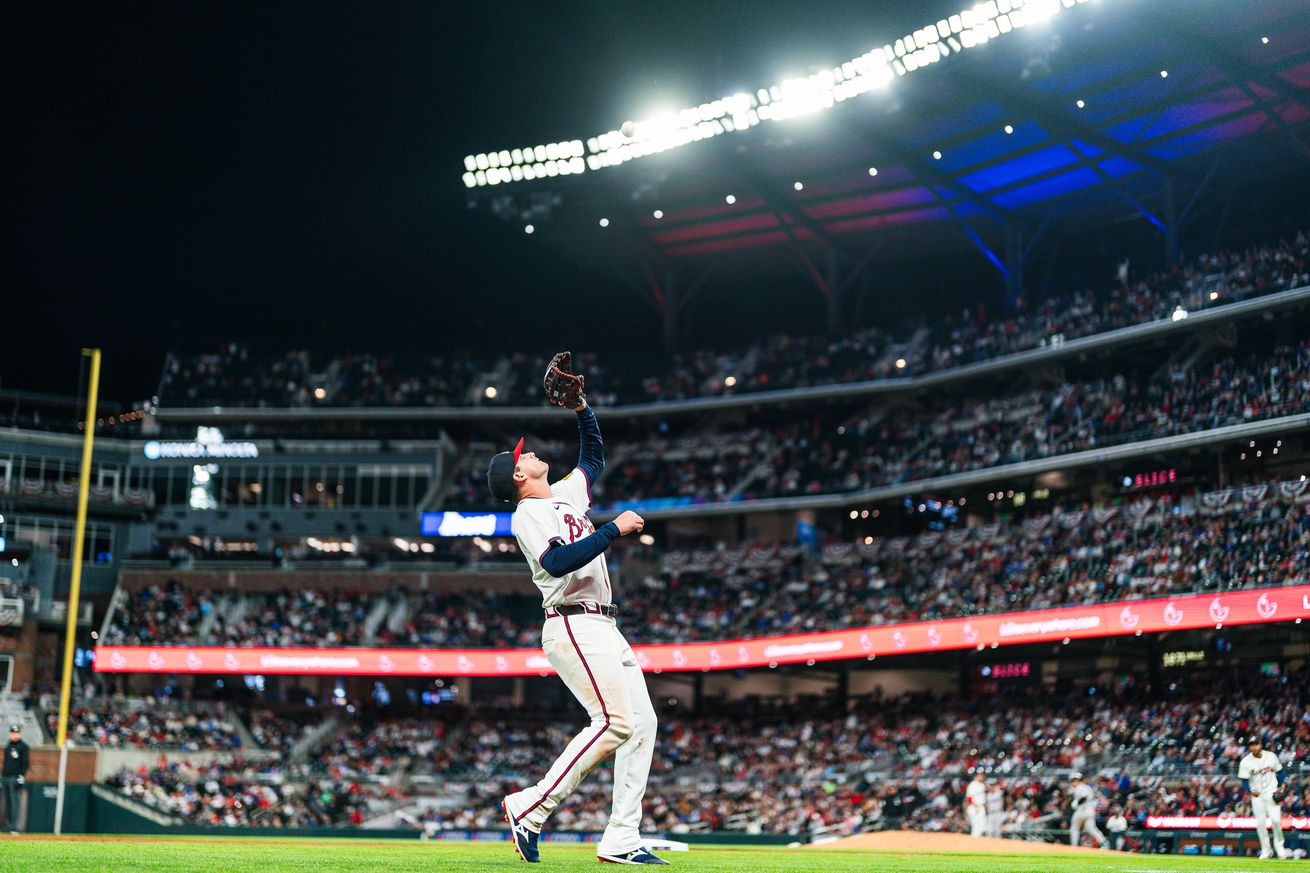
Let’s talk about moving Austin Riley out to left field. What happens with the Braves then?
It’s weird that a cheese cleaver became a very integral of my life. I don’t even really like cheese.
When my cat had a thyroid condition that made her throw up without this nausea medication and the pill needed to be cut in half, enter the cheese cleaver because … what else do you chop tiny pills with?
When we moved into our new house, one of our decorations needed a piece of tape on the back of it, but I couldn’t really get my hand around back to get the tape down against the wall and the decoration. Enter the cheese cleaver.
When there was a screw that was too small for the screwdriver I had handy, enter the cheese cleaver corner.
When we needed to open a bag, enter the cheese cleaver that was just sitting right there.
The original purpose of that cheese cleaver was none of those things, but given that we don’t … cleave cheese? … a lot in our house, we found other uses for it that made sense for us.
Enter this Statcast data below.

And these other defensive metrics (total values all the way to the right).

Defensive metrics are notoriously tricksy from one year to another, but this seems fairly clear. Whoever this is, they aren’t very good at their position.
That person, as you might have guessed by this point, is Austin Riley.
To be fair, this ultimately isn’t that awful. Riley has been about middle of the pack defensively in terms of starting third basemen for several years now, and he’s come a long way from the days where his first throw of the game was … an adventure, shall we say. The point of this isn’t to say we need to move Austin Riley from third.
But I do want us to consider it.
The first thing we need to think about is the Atlanta Braves’ current roster situation. At third base, the team has Austin Riley, who is probably one of the top five-ish third basemen in the game. In left field, the team has … Jarred Kelenic, who … is not one of the top five-ish left fielders in the game.
Looking down in the minors … well, there aren’t a lot of good position player prospects, but there are two who are near the majors – Nacho Alvarez and Drake Baldwin. Neither of those guys, however, plays third or left, but even if you squint hard enough at Nacho, he’s really nacho answer in this situation either.
So, this means if Atlanta were to move Riley to left, they’d be creating a hole at third along with making Riley play a new-ish position (he’s done it before but not a lot).
“Mark, you are really not selling this, my friend.”
“Well, I’d argue I’m not trying to *sell* you on it. I’m going through a thought exercise here.”
“Fine, then move along.”
So if they do this, the Braves need to replace him externally. Who would that be?
One of the things I like to do is break players into tiers, and I do that through standard deviations. You might remember discussing standard deviations a month ago or so, but in this case, just think of breaking players into tiers across the 20-80 scouting scale. That’s effectively what we’re doing, and below is the third base set of tiers with fWAR and “scouting grades” (standard deviations based on fWAR projections for 2025).
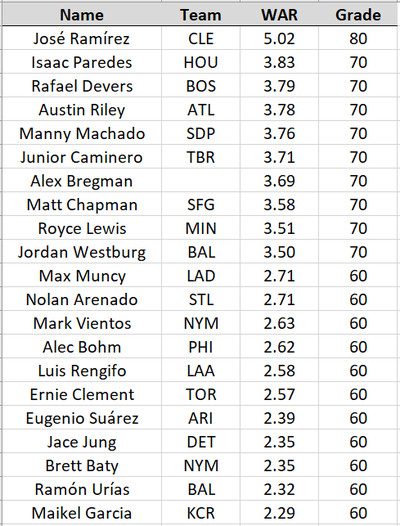
These are Steamer/600 projections, so these take their projections and put them into 600 PA. It’s not an exact science here (Ernie Clement, what), but it gives you a decent look at how third basemen break down. To be clear, the Grade here is just considering third basemen.
Riley fits in the 70 tier (All-Stars). Effectively, everyone else in the 70 tier is roughly the same kind of player, and looky who we got here, there’s Alex Bregman. A tier below that (good starters), we have Nolan Arenado. I don’t know that there’s anyone else on this list that are particularly available (at least to the Braves – see Bohm, Alex) or anyone I’d be desperate to acquire with confidence that they can be a really good starter in 2025.
Alex Bregman is in a bit of a pickle when it comes to his free-agency. If he had free-agency after 2022, he would have been 28 and would have just been a 5.5-ish win player. Two years later, his production has been dwindling, and although that has been down to just a 4-win player, that’s not a great trajectory for someone officially on the wrong side of 30. Below are his Statcast numbers.
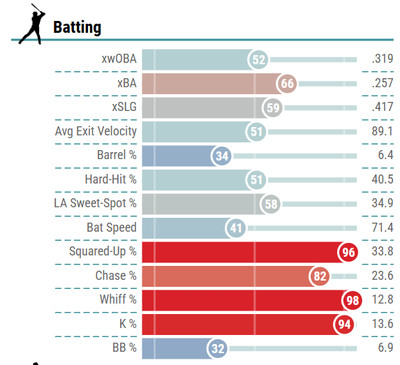
It’s mixed, but it’s not awful. Looking back on the past couple seasons, it’s definitely worse than 2022, but it’s not that much worse than 2023. He is actually hitting the ball harder, just not hitting the ball that hard as often. Defensively, he’s quite a bit better because of his range, though his arm isn’t great.

Contractually-speaking, MLB Trade Rumors predicted a 7-year, $182 million contract, but … I don’t think that’s happening at this point. The longer his free-agency goes on, the more likely it is that he takes a smaller contract or a one-year pillow deal. We haven’t gotten that far, but if he were to go that direction, I’d be interested.
Nolan Arenado is a bit of a different case. He’ll be 34 just a few weeks after Opening Day, and while the bat has slipped from a 149 wRC+ in 2022 to 102 last season, the defense has remained good enough to keep him a 3-win player.

The offense, though, woof …
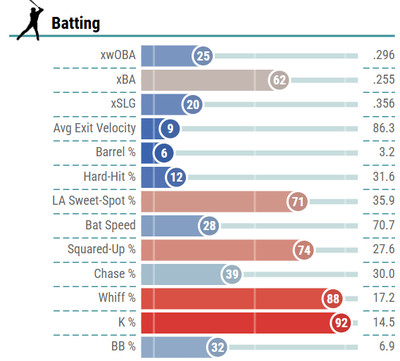
He’s still making a lot of contact, but the contact is pretty bad. The decline seems to be in full swing, and I don’t think the team wants to be anywhere near it or the substantial amount of money he’s owed over the next three seasons. Even if the Cardinals were to eat a lot of the contract, they’d need to basically eat all of it for me to consider this.
Okay, so that leaves Bregman getting a short-term contract. I’m not seeing it.
The other aspect of this is who can the Braves get to improve left field and keep Riley at third.
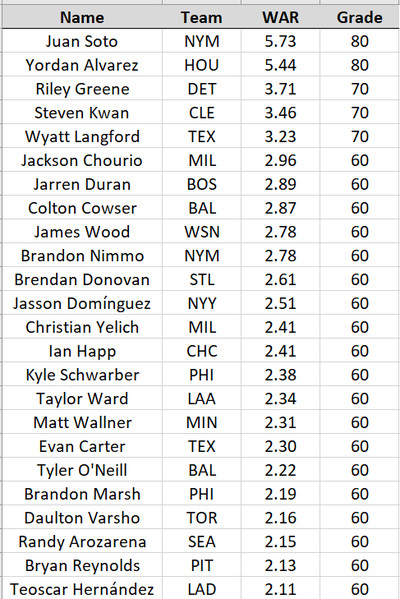
This is the same thing we did for third basemen, but this time, it’s for left fielders. It’s … well … not inspiring. O’Neill and Hernandez were available as free-agents, but they are already elsewhere for 2025. I’m not sure there are a ton of other available options on this list other than if the Blue Jays ultimately punt on 2025 and are willing to send out Daulton Varsho. For funsies, Riley’s offensive projection along with being average-ish in left field would put him in the top 5 here as well.
There are two other decent options that are still available as free-agents – Jurickson Profar and Anthony Santander. Austin covered Profar not too long ago, and his projection throws him just a little further down this list at 1.9 WAR for 2025. Santander is projected at 2.2 (for RF, which is why he’s not on the list above). So there are a couple options to team up with Kelenic, even if they aren’t exactly inspiring.
Okay, so are we moving Riley or not?
My guess is that, ultimately, this isn’t even something the Braves are considering for a few good reasons.
One is that Riley is one of the top third basemen in the game. Moving him to left field (or any other position) is a risk when you already know he’s really productive where he is now.
The next is the defense isn’t *awful*. Even if he’ll turn 28 right after Opening Day and defense generally doesn’t age well, 28 isn’t old or near old. He’s survived this long while not being great, and there’s nothing in the defensive metrics that really indicates that he’s getting worse. I wouldn’t expect him to get better, but I don’t expect him to get a lot worse any time soon, either.
Three, you need Riley’s buy-in. Upsetting one of the better players in the game and on the team who seems to be a leader in the clubhouse seems like a bad idea. In order to get him to go along with this, the Braves are likely going to have to show him that they could acquire Bregman, which would put the team in a better position to win a World Series. It’s more of a move that you make in a video game.
Finally, once you’ve done this, you’re likely committing to it long-term. There’s not really much of a reason to give Bregman a pillow contract, move Riley to left field for one season, and then move Riley right back to third once he’s finally started to get comfortable in left. It would make more sense if Atlanta was able to get Bregman to commit to a 4 or 5-year deal worth $20-25 million a year and make the move permanent.
We went through all of this for nothing?
Well, yes and no.
One of the things that Atlanta is going to face by the time Riley’s contract is up in … 2032 … is moving him to a different position. Olson is at first through 2029, and putting him at DH is a poor use of Riley’s surprising-for-the-look-of-him athleticism. So left field is the natural solution, and I do think it will have to happen by the end of the decade. They’re going to have to upset him at some point, and I’m not sure it matters when it happens.
But does it have to happen this season? No, but it’s probably worth considering if Atlanta were to find a way to grab Bregman, who’s one of the few impact free agents left.
